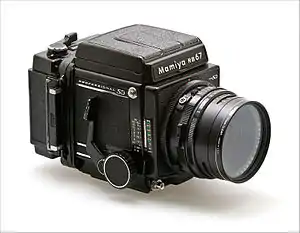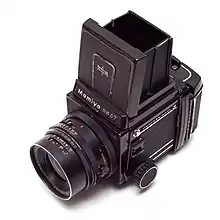Mamiya RB67
The Mamiya RB67 is a professional medium format single-lens reflex system camera manufactured by Mamiya.[1][2] There are three successive models: the RB67 Professional (released in 1970), RB67 Pro-S (released in 1974) and RB67 Pro-SD (released in 1990). It is primarily designed for studio use, but can also be used in the field.
 | |
| Overview | |
|---|---|
| Maker | Mamiya |
| Type | Medium Format SLR |
| Released | 1970 RB67 Professional 1974 RB67 Pro-S 1990 RB67 Pro-SD |
| Production | 1970-2010 |
| Lens | |
| Lens mount | Custom Mamiya breech-lock bayonet mount |
| Sensor/medium | |
| Recording medium | 120 film |
| Focusing | |
| Focus | Manual |
| Exposure/metering | |
| Exposure | Manual |
| Flash | |
| Flash | PC socket |
| Shutter | |
| Frame rate | Manual lever winding, unmodified. |
| Shutter speed range | 1 s to 1/400 s, Time |
| General | |
| Dimensions | 104×139×226 mm (4.1×5.5×8.9 in) (W×H×L) (with the 90 mm f/3.8 lens) |
| Weight | 2.69 kg (5.9 lb) |
| Made in | Japan |
Details
The RB67 Professional was introduced in 1970 with a similar look to conventional medium format SLR cameras like the Hasselblad, but was larger due to the 6×7 cm frame format, closer to the typical 8×10 inch aspect ratio of portraits. However, the RB67 differed visually from other 6x7 cameras of the time, which resembled very large 35 mm cameras.[3]: 168
There are three successive models: the RB67 Professional (first model released in 1970), RB67 Pro-S (released in 1974) and RB67 Pro-SD (released in 1990). The RB67 is a modular camera system, meaning lenses, viewfinders, ground glasses, film winders and film backs are all interchangeable. It is primarily designed for studio use, but can also be used in the field. There is no shutter in the RB67; the Sekor lenses have built-in mechanical leaf shutters which are cocked and triggered from the body. Focusing is performed with a bellows on the body. It is a completely mechanical camera requiring no batteries.
The camera accepts 120 and 220 film, with interchangeable film backs configured for exposures of 6x7cm or 6x4.5cm. Special-purpose film backs allow for motorized operation, 6x8cm exposures, or use of 70 mm film or Polaroid film.[4] Multiple exposures are possible in the M-mode. Mirror flip up is supported. It measures 104×139×226 mm (4.1×5.5×8.9 in) (W×H×L) with the 90 mm f/3.8 lens, and weighs approximately 2.69 kg (5.9 lb). The flange distance is 110 mm.[5]
The RB in the name stands for "Rotating Back", a concept dating back to early Graflex cameras as early as 1907.[6]: 81 The RB67 takes backs which can be rotated 90 degrees to provide a horizontal or vertical composition. The orientation is shown in the viewfinder with a combination of black and red lines, the latter indicating landscape orientation.[3]: 168
The Mamiya evolution
Mamiya began producing folding cameras for 120 size medium format film in 1940 during WWII. They introduced their first medium format twin lens reflex camera in 1948, and through the 1950s they built TLR cameras similar to the German Rolleiflex Automat. In 1957 they introduced the Mamiyaflex C which incorporated several common features from large format press cameras: a bellows focussing system, and interchangeable lenses. It is regarded as the most advanced TLR system of the time; one of the few TLRs with interchangeable lenses.[7]: 154 Despite their initial popularity with the press, by the late 1960s other companies were successfully producing and marketing medium format SLRs with exchangeable film backs, allowing a photographer to switch film types easily—not needing multiple cameras.
While several competitors offered medium format SLR cameras, there was not a successful offering with bellows focussing and a rotating back. There are also advantages to having a leaf shutter incorporated into the lens, especially for flash synchronization (Sherman Pg 86). New medium format SLR offerings in the late 1960s like the Pentax 6×7, began to resemble a conventional 35 mm SLR cameras, with interchangeable viewfinder and lenses, and horizontal film paths. To compete, Mamiya added the RB67 alongside their advanced TLR, the C330, but using SLR, a horizontal film path, and exchangeable film magazines, while retaining the bellows focus and front-leaf shutter system.[3]: 317 Polaroid exchangeable backs allowed instant photography with many professional cameras including the RB67.[8]: 167
The concept is similar in layout to Hasselblad cameras, though the RB67 is much larger and heavier,[3]: 165–167 due to the inclusion of traditional professional features such as bellows focussing and the rotating back.
See also
References
- Madison, James (13 February 2020). "Five Times Bigger Than Full Frame at a Fraction of the Cost: The Mamiya RB67". Fstoppers. Retrieved 2021-11-14.
- Madison, James (12 April 2021). "A Long Term Review Of the Mamiya RB67 Pro-SD". Fstoppers. Retrieved 2021-11-14.
- Gustavson, Todd (2011). 500 Cameras, 170 Years of Photographic Innovations. Sterling Signature. ISBN 1402780869.
- "Mamiya RB67 Camera Guide - Backs". helluin.org. Retrieved 2023-04-30.
- "Guide to Understanding Flange Focal Distance". briansmith.com. 18 March 2016. Retrieved 2022-01-25.
- Williamson, David (2003). Comprehensive Guide for Camera Collectors. Schiffer. ISBN 0764319760.
- Coe, Brian (1988). Cameras From Daguerreotypes to Instant Pictures. Crown. ISBN 0517533812.
- Levy, Michael (2001). Selecting and Using Classic Cameras. Amherst. ISBN 1584280549.
General references
- Shell, Bob. Mamiya Medium Format Systems. Hove Pro-Guide. Hove: Hove Photo, 1992. ISBN 9780906447765.
- Moore, Paul. Shooting Old Film Cameras – Mamiya RB67 Professional. Self-published, 2013. ISBN 1481964895.
- Gustavson, Todd. Camera: a History of Photography from Daguerreotype to Digital. Sterling Signature, 2012. ISBN 1454900024.
- Sherman, Bennet. Leaf Shutter SLR: Why?. Popular Photography. January 1960.


